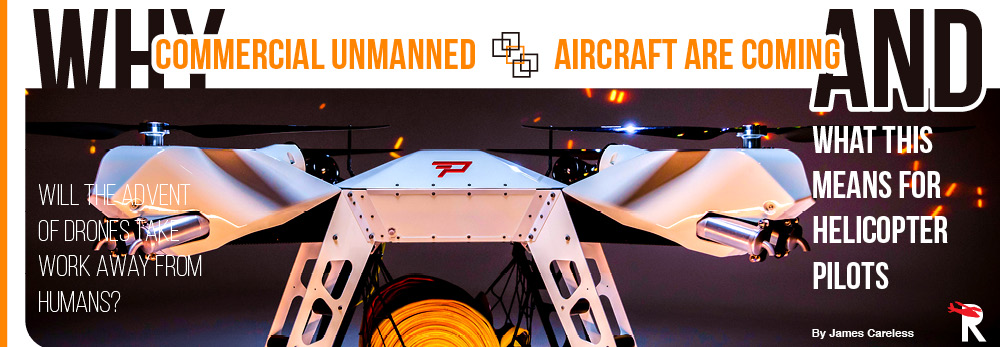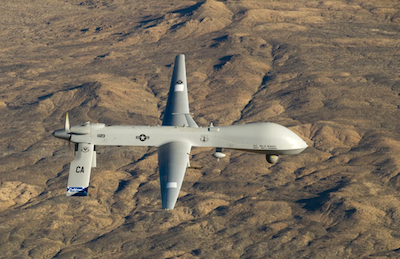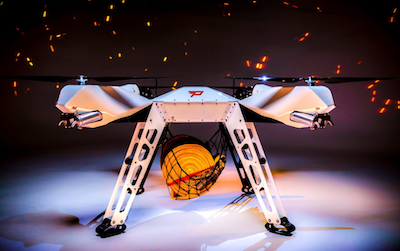|
Jun
14
2021
|
|
Posted 4 years 218 days ago ago by Admin
|
|

For any helicopter pilot paying the scantest bit of attention to the news, the conclusion is inescapable: Commercial unmanned aircraft – a.k.a. drones – are no longer toys. They have grown in size, payload capacity, mission profiles, and range to become bonafide aerial platforms.
The fact that commercial unmanned aircraft are achieving ‘critical mass’ (the minimum size or amount of something required to start or maintain a venture) raises big questions for helicopter pilots: Will the advent of drones take work away from humans? Or does this emergence open up vast new possibilities for aerial applications – and new employment opportunities for pilots as a result?
Here’s what we know so far.
Drones Are Ascending
Surprisingly, functional unmanned aircraft have existed for more than 100 years. In the mid-1910s the British RAF were developing radio-controlled unmanned ‘Aerial Target’ aircraft to take out German Zeppelins proving just how useful unmanned aircraft could be in military deployment, a fact reinforced by the heavy use of surveillance/attack drones (such as the USAF’s MQ-1 Predator) in the world today.

It is only now that drones are taking off in the commercial sector. Robin Riedel, a partner in the consulting firm McKinsey & Company, who covers the disruptive aerospace sector, says that there are three ‘unlocks’ that explain why this is happening today. “The first unlock is battery density or the amount of energy that can be stored in a battery at a given weight,” Riedel says. “We’re now at the point where batteries have sufficient density to provide the power that commercial unmanned aircraft need at weights that they can afford to carry aloft.”
“The second unlock is the amount of flight/sensor data and onboard artificial intelligence that we can use in drones to allow them to fly in an autonomous/self-flying mode and to carry out pre-programmed flight paths with minimal human intervention,” Riedel adds. “The third unlock is the public’s growing acceptance of unmanned aircraft, now that consumers have become accustomed to buying toy drones for their kids at Christmas.”
There are other factors that have resulted in commercial unmanned systems achieving critical mass. They include the development of helicopter-like multirotor aircraft capable of lifting heavy payloads and the work being done to integrate drones into air traffic control systems, which makes beyond-visual-line-of-sight flights safely possible for unmanned aircraft.
Finally, there’s one more reason that these drones are taking off, namely their ability to fly missions that are not economically nor prudent for manned aircraft to fly on their own. “Today’s drones are being offered as turnkey solutions for business,” says Riedel. “Providers are selling flight management software that allows you to choose destinations by just placing markers on your iPad screen.”
Brave New World of Flight
Juan Plaza is CEO of Juan B. Plaza Consulting, which provides guidance on issues regarding unmanned aircraft and general aviation to customers. Plaza is also a pilot, aerial photographer/mapper, writer, and an expert on the emerging commercial drone industry.
Urban aerial mobility (UAM) is one area where Plaza expects commercial drones to proliferate. UAMs are basically unmanned aerial taxis that use electrical motors to fly passengers short distances. “For instance, the Uber Elevate UAM initiative is based on the notion that it is far cheaper to fly a four-passenger autonomous or remotely piloted air taxi over New York City’s gridlocked streets than it is to pay for a helicopter ride with an onboard human pilot,” he says. “Anywhere where driving is a problem and helicopters are expensive, AI-controlled air taxis that run on electric batteries will be an affordable and effective alternative.”
It is for this very reason that Airbus Helicopters has established its own UAM manufacturing division. It is currently working on CityAirbus, an all-electric, four-seat multicopter demonstrator meant to prove the concept of remotely piloted electric vertical takeoff and landing (eVTOL) flight. This prototype conducted its first takeoff in May 2019.

“Urban air mobility is a key element in Airbus’ zero emission strategy,” says Balkiz Sarihan, head of UAM strategy execution & partnerships at Airbus. “It is also essential to our long-term strategy of driving the development of ‘techno-bricks’ such as autonomy, connectivity, and fully electric flight that will benefit both traditional helicopters and the future urban air mobility market.”
“On the purely technical side of things, we have taken a demonstrator approach to mature the techno-bricks that we will need for a certifiable aircraft,” Sarihan adds. “The result from our tilt-wing Vahana flights have already been analyzed. Testing with our real-sized CityAirbus multicopter vehicle is still ongoing. This allows us to learn a maximum amount about the possible architectures in the shortest possible time.”
California’s Parallel Flight Technologies (PFT) has a different take on the commercial unmanned aircraft market. Having seen the difficulties faced by manned helicopters during the state’s many wildfires, this company is developing autonomous heavy-lift drones to supply firefighters in the most dangerous of flight conditions. They are developing a unique long-range parallel hybrid (electric/gas generator) configuration.
Joshua Resnick, PFT CEO and co-founder almost lost his home to a California wildfire, so the passion he feels for this project is personal. “Using manned helicopters, our firefighters only get air support for eight hours a day on average,” Resnick says. “It is just too dangerous for humans to fly at night over wildfires in IFR conditions. However, an autonomous heavy-lift drone can fly at night and in other situations too dangerous for pilots, because no lives are being put at risk. This means that supplies can be flown in around the clock, which would be a huge boon to firefighters on the ground.”

Resnick sees this technology as also being useful for provisioning remote villages in Alaska, where, he says, fog can prevent manned aircraft from landing for days or even weeks. Such missions could bring in life-saving medical supplies in places where roads, railways, and regular airports don’t exist and the sea is frozen most of the year.
These are just some of the new missions open to unmanned aircraft. Others include, using aerial inspections and using courier trucks as ground-based aircraft carriers.
“Compared to helicopters, unmanned aircraft can provide economical and efficient alternatives for inspecting power lines, water tanks, and other missions,” says Riedel. “You can even use remotely controlled small drones to inspect tanks from the inside, removing the risk to in-place humans from the job while doing it as well as they can, or better.”
As for package deliveries? “With just one autonomous drone on their truck, a FedEx driver could double their ability to deliver packages,” Plaza says. “With three, they could quadruple it.” He predicts a not-so-distant future where “when you’re grilling sausages outdoors and you run short, you won’t run out to the store. Instead, you’ll order them through Amazon and a drone will deliver them in minutes to a special landing pad at your home.”
Fedex Drone Delivery video https://www.youtube.com/watch?v=vHXY0L8SlHE
Unmanned Aircraft Will Affect Helicopter Pilots
At first glance, the amazing possibilities offered by unmanned aircraft can be intimidating to human helicopter pilots. It is quite natural to wonder what jobs will be left for people once the robots have taken to the air.
Well, fear not. The advent of unmanned systems won’t make human pilots obsolete.
In the near term, the current state of autonomous flight technology, plus the understandable caution of the FAA and other aviation regulators towards this technology, means that air taxis and other UAMs will require human pilots for the time being. “I foresee humans flying these aircraft during the first 10-20 years of urban air mobility,” says Plaza, “whether directly onboard or remotely by wireless.”
The continued need for pilots is echoed by Airbus Helicopters. “Even though the current generation of the CityAirbus has an automated flight mode that is operational now, we have a pilot in the ground station,” Sarihan says. “We are planning for the fact that the initial phase of urban air mobility that will be transporting people from point A to point B will require a pilot for regulatory and technical reasons. This includes the safe integration in the airspace that we expect will not be possible in a fully autonomous mode in the near future.”
Meanwhile, the possibilities offered by unmanned aircraft means that the job of human piloting will evolve to adapt to them, in the same way that the replacement of horses by cars resulted in more than just ‘horseless carriages’ travelling at the same speeds and doing the same things..
The ‘aircraft carrier’ model of package delivery is just one example: A mix of manned and unmanned aircraft could be highly effective in search-and-rescue missions for locating missing people in hostile weather. Drones could also be used to deliver life-saving supplies to them whenever manned helicopters have to wait for safe flying conditions to return.
Bell APT Military video https://vimeo.com/440433961
“Moreover, you still need humans on SAR missions to rescue people and provide them with emergency medical treatment,” says Riedel. “You will still need pilots to fly those and other similar missions. So unmanned aircraft won’t replace manned helicopters. They will supplement them.”
For helicopter pilots, the best way to cope with the arrival of unmanned aircraft is to identify areas of new opportunities and to pursue them when doing so makes sense. Yes, change is definitely coming to manned helicopter flight, but it doesn’t have to be a bad change. In fact, drones may end up doing the dangerous ‘drudge work’ previously done by human pilots, freeing them to do the most interesting and fulfilling missions.